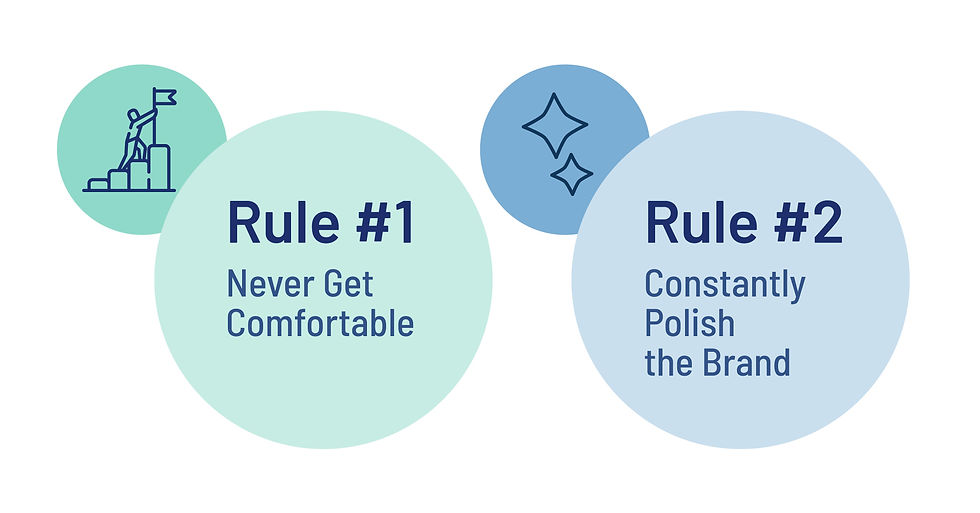How To Improve Brand Reputation
- Jun 16, 2022
- 4 min read
Recognizing When Your Brand Is Losing Its Luster

If your marketing seems less effective or success benchmarks aren’t being met, it may be time to evaluate your brand reputation. Though some shifts in performance can be attributed to the ever-fickle consumer and rapidly changing marketing trends, sometimes the problem can lie deeper beneath the surface and may require long-term solutions. So how do you tell if your brand is losing its luster? And how do you stay nimble enough to avoid a sliding brand reputation?
Start by examining the relationship between brand and reputation. Your brand is the promise you make to audiences. You earn a reputation by how you fulfill that promise. When the gap between those begins to widen is when the brand begins to slide. You can be a bright, shining star one day with the brand reputation of a dull pariah the next.
Learn from Major Retail Brands
Paying close attention to the state of your brand’s reputation could save you from being faced with a timely and expensive rebranding effort on top of falling revenues. One retail brand that failed to keep up with its changing reputation is early 2000s fashion icon, Abercrombie and Fitch. The fashion brand hinged its success on a marketing strategy of elitism, positioning itself as the way teenagers can look cool. Abercrombie & Fitch quickly fell from grace as changing social attitudes about racial diversity and size inclusivity stood in opposition to the brand’s messaging.
When a class-action racial discrimination lawsuit against the company came to light, it was clear Abercrombie & Fitch needed serious changes in its culture and messaging. In 2017, the brand underwent a full transformation to improve its brand reputation resulting in a resurgence of success with Gen Z consumers. Carey Collins Krug, Abercrombie Brands' senior vice president and head of marketing told TeenVogue, “Abercrombie today isn’t about ‘fitting in,’ but instead is focused on creating [a] space where everyone genuinely belongs.”
Toxic company culture—mistreatment of employees, discrimination of any kind, misinformation, and inauthenticity—can also quickly tarnish a brand. Marketers across many industries can learn lessons from retail brands like Abercrombie & Fitch. Test your brand regularly to make sure you're still relevant and well received by your target audience.
Don't be afraid to ask hard questions.

Rule #1—never get comfortable or take your eyes off the ball.
Rule #2—constantly polish the brand and monitor your reputation.
How do stakeholders view your brand? Ask them. Perception research is critical to evaluating marketing programs and determining if messages resonate with audiences as authentic, truthful, and what they want.
Whether in-depth consumer and brand studies or short post-visit patient surveys, digital platforms place invaluable data at your fingertips. Questions or comments posted on websites or social channels can also warn of shifting consumer behaviors.
In monitoring your brand, monitor the competition as well. Look for areas where they may be outshining you or losing some of their lusters.
Step outside the marketing bubble to test the brand promise.
Being too close to creating and marketing a brand can skew the perceptions of even the most experienced marketing professional. If you haven't tested your brand promise since pre-2020, quickly do so.
Does the promise resonate with patients, employees, doctors, and community stakeholders? Does it resonate with your barber, barista, or mother? If the reaction is "what does that mean?" you know it's time to refresh the brand.

This consumer-driven marketplace requires three traits:
Empathy
Trust
Authenticity
For years, Starbucks' brand promise was considered the best of the best: "To inspire and nurture the human spirit—one person, one cup, and one neighborhood at a time." Starbucks positioned itself as a warm gathering place to find comfort, community, and consistently good coffee. So, what happened? Even that brand has faded.
Along the way, the company grew to be the third-largest global restaurant chain. Even before the pandemic, some 80 percent of orders were to-go, and one-fifth were through the mobile app. There are now stores for app-only orders and with no seating. It outgrew its brand promise and lost the warm, human touch.
Strike a balance between promise and fulfillment.
In that balance lies brand trust. It lives at the intersection of words and action, personal and community needs. What you say, what you do. What you are doing for society; what you are doing for the individual customer.

The Edelman Trust Barometer 2020 special report, "Brands Amid Crisis," chronicled consumer values that quickly shifted from aligning with brands reflecting social status, success and lifestyle to those that put consumer safety first, showed value and cared more about people than profit. Edelman's 2021 Trust Barometer declared a complete information bankruptcy, with consumers mostly distrusting everyone.
For your brand to stay relevant and resonate with audiences, remember they are watching how you treat employees, what you're doing for the community's health, how you're taking care of them and how you react in times of crisis.
To retain brand trust with audiences, stay ahead of them. Implement such tactics as:
Provide the best digital experiences possible from website to mobile apps.
Curate content that's authentic and relevant, not platitudes about the brand.
Invest and engage with community needs.
Position leadership as leaders in the community, particularly in times of crisis.
Identify micro-influencers whose brand values align with yours; leverage their influence.
Listen to them.
In this time of rapidly shifting consumer perceptions and social attitudes, move swiftly and strategically if you recognize that your brand is beginning to lose its luster.
If you feel your brand may be losing its luster, we can help with strategic planning, rebranding, and more. Email Lori Moore or call TotalCom Marketing Communications at 205.345.7363.



Komentáře